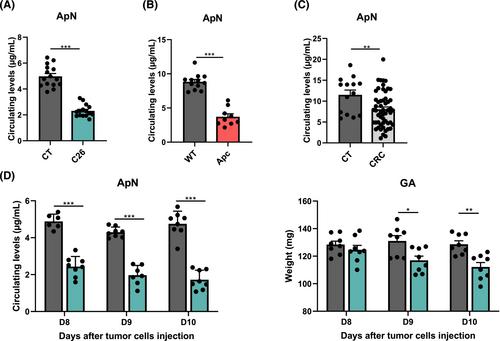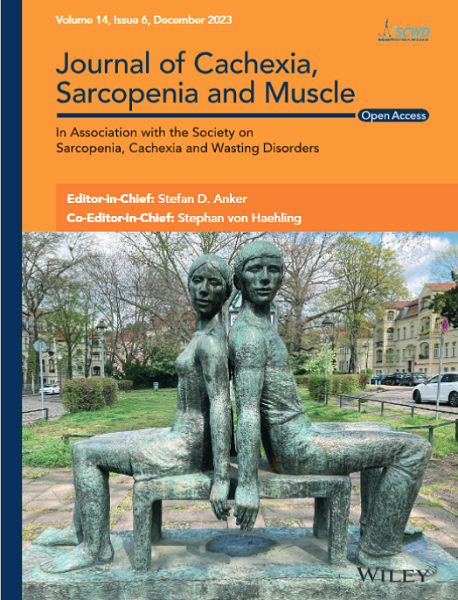Administration of adiponectin receptor agonist AdipoRon relieves cancer cachexia by mitigating inflammation in tumour-bearing mice
Abstract
Background
Cancer cachexia is a life-threatening, inflammation-driven wasting syndrome that remains untreatable. Adiponectin, the most abundant adipokine, plays an important role in several metabolic processes as well as in inflammation modulation. Our aim was to test whether administration of AdipoRon (AR), a synthetic agonist of the adiponectin receptors, prevents the development of cancer cachexia and its related muscle atrophy.
Methods
The effect of AR on cancer cachexia was investigated in two distinct murine models of colorectal cancer. First, 7-week-old CD2F1 male mice were subcutaneously injected with colon-26 carcinoma cells (C26) or vehicle (CT). Six days after injection, mice were treated for 5 days with AdipoRon (50 mg/kg/day; C26 + AR) or the corresponding vehicle (CT and C26). Additionally, a genetic model, the ApcMin/+ mouse, that develops spontaneously numerous intestinal polyps, was used. Eight-week-old male ApcMin/+ mice were treated with AdipoRon (50 mg/kg/day; Apc + AR) or the corresponding vehicle (Apc) over a period of 12 weeks, with C57BL/6J wild-type mice used as controls. In both models, several parameters were assessed in vivo: body weight, grip strength and serum parameters, as well as ex vivo: molecular changes in muscle, fat and liver.
Results
The protective effect of AR on cachexia development was observed in both cachectic C26 and ApcMin/+ mice. In these mice, AR administration led to a significant alleviation of body weight loss and muscle wasting, together with rescued muscle strength (P < 0.05 for all). In both models, AR had a strong anti-inflammatory effect, reflected by lower systemic interleukin-6 levels (−55% vs. C26, P < 0.001 and −80% vs. Apc mice, P < 0.05), reduced muscular inflammation as indicated by lower levels of Socs3, phospho-STAT3 and Serpina3n, an acute phase reactant (P < 0.05 for all). In addition, AR blunted circulating levels of corticosterone (−46% vs. C26 mice, P < 0.001 and −60% vs. Apc mice, P < 0.05), the predominant murine glucocorticoid known to induce muscle atrophy. Accordingly, key glucocorticoid-responsive factors implicated in atrophy programmes were—or tended to be—significantly blunted in skeletal muscle by AR. Finally, AR protected against lipid metabolism alterations observed in ApcMin/+ mice, as it mitigated the increase in circulating triglyceride levels (−38%, P < 0.05) by attenuating hepatic triglyceride synthesis and fatty acid uptake by the liver.
Conclusions
Altogether, these results show that AdipoRon rescued the cachectic phenotype by alleviating body weight loss and muscle atrophy, along with restraining inflammation and hypercorticism in preclinical murine models. Therefore, AdipoRon could represent an innovative therapeutic strategy to counteract cancer cachexia.


 求助内容:
求助内容: 应助结果提醒方式:
应助结果提醒方式:


